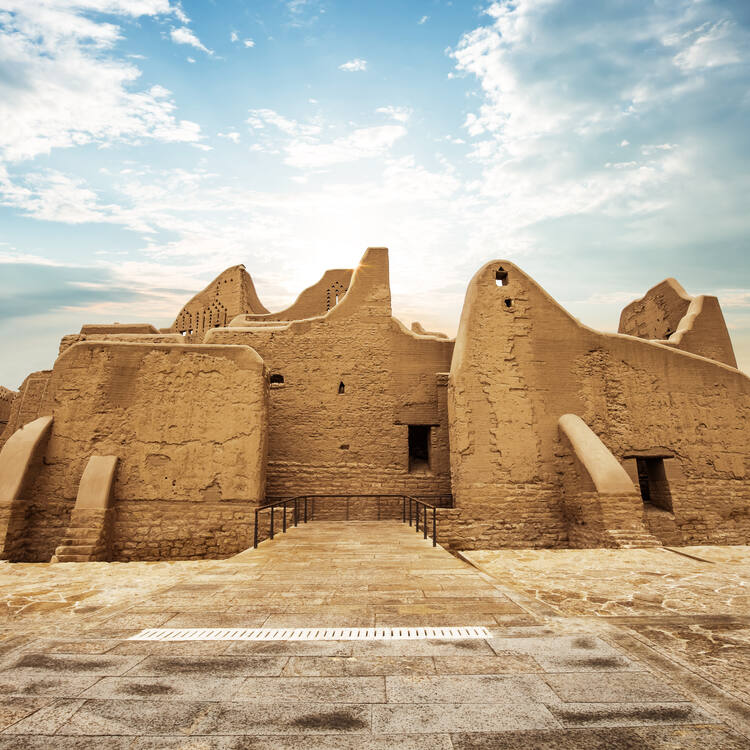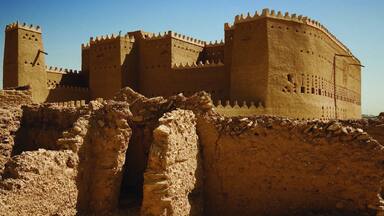At-Turaif District in ad-Dir'iyah
At-Turaif District in ad-Dir'iyah
This property was the first capital of the Saudi Dynasty, in the heart of the Arabian Peninsula, north-west of Riyadh. Founded in the 15th century, it bears witness to the Najdi architectural style, which is specific to the centre of the Arabian peninsula. In the 18th and early 19th century, its political and religious role increased, and the citadel at at-Turaif became the centre of the temporal power of the House of Saud and the spread of the Salafiyya reform inside the Muslim religion. The property includes the remains of many palaces and an urban ensemble built on the edge of the ad-Dir’iyah oasis.
Description is available under license CC-BY-SA IGO 3.0
District d’at-Turaif à ad-Dir’iyah
Ce site fut la première capitale de la dynastie saoudienne, dans le centre de la péninsule arabique, au nord-ouest de Ryad. Fondée au 15e siècle, elle témoigne du style architectural Nadji, propre au cœur de la péninsule arabique. Au 15e et au début du 19e siècle, son rôle politique et religieux s'est accru et la citadelle d'at-Turaif est devenue le centre du pouvoir temporel des Saoud et de la diffusion de la réforme salafiyya au sein de la religion musulmane. Le bien comprend des vestiges de nombreux palais et d'un ensemble urbain érigé en bordure de l'oasis ad-Dir'iyah.
Description is available under license CC-BY-SA IGO 3.0
حي الطريف في الدرعية
شكل هذا المكان الذي يقع في قلب شبه الجزيرة العربية، شمال غرب الرياض، أول عاصمة لأسرة آل سعود. ويحمل حي الطُّريف الذي أُسس في القرن الخامس عشر آثار الأسلوب المعماري النجدي الذي يتفرد به وسط شبه الجزيرة العربية. وتنامى في القرن الثامن عشر وبداية القرن التاسع عشر، الدور السياسي والديني لحي الطريف وأضحى مركزاً لسلطة آل سعود وانتشار الإصلاح السلفي في الإسلام. ويضم هذا الممتلك آثار الكثير من القصور، فضلاً عن مدينة بُنيت على ضفاف واحة الدرعية.
source: UNESCO/CPE
Description is available under license CC-BY-SA IGO 3.0
德拉伊耶遗址的阿图赖夫区
此处遗址是沙特王朝的第一任首都所在地,位于阿拉伯半岛中部,利雅得西北部,始建于15世纪。这里仍然可以看到阿拉伯半岛中部特有的纳吉迪建筑风格。18 世纪期间及19世纪初,随着政治和宗教的作用加强,阿图赖夫区的城堡成为了沙特王室临时权力中心,以及穆斯林宗教内部传播瓦哈比教派改革的中心。这一遗址包括了许多宫殿遗迹和一处在德拉伊耶绿洲边缘兴建的城市区域。
source: UNESCO/CPE
Description is available under license CC-BY-SA IGO 3.0
Район ad-Dir’iyah в городе ad-Dir’iyah
Этот объект являлся первой столицей Династии Саудитов, в самом сердце Аравийского полуострова на северо-западе от Эр-Рияда. Основанный в15 веке, он свидетельствует об архитектурном стиле Najdi, свойственном центру Аравийского полуострова. В 18 и начале 19 вв., его политическое и религиозное значение выросло, и цитадель в at-Turaif стала центром временной власти Саудитов и источником распространения Ваххабизма в мусульманской религии. Объект включает руины множества дворцов и городской ансамбль, построенный на краю оазиса ad-Dir’iyah.
source: UNESCO/CPE
Description is available under license CC-BY-SA IGO 3.0
Distrito de At Turaif en ad Dir’iyá
El sitio, situado al noroeste de Riad, en el corazón de la Península Arábiga, albergó la primera capital de la dinastía saudí. Fundado en el siglo XV, contiene testimonios del estilo arquitectónico najdi, característico del centro de la Península Arábiga. En el siglo XVIII y principios del siglo XIX, su papel político y religioso se hizo más importante y la Ciudadela de At-Turaif se convirtió en el centro del poder temporal de la casa de Saud y de la expansión del reformismo salafiyya en el seno de la religión musulmana. El sitio inscrito incluye los vestigios de numerosos palacios y un conjunto urbano construido en los confines del oasis de ad-Diriyá.
source: UNESCO/CPE
Description is available under license CC-BY-SA IGO 3.0
ディルイーヤのトライフ
source: NFUAJ
At-Turaif district in ad-Dir’iyah
Source: unesco.nl
Outstanding Universal Value
Brief synthesis
The At-Turaif District in ad-Dir'iyah was the first capital of the Saudi Dynasty, in the heart of the Arabian Peninsula, north-west of Riyadh. Founded in the 15th century, it bears witness to the Najdi architectural style, which is specific to the centre of the Arabian Peninsula. In the 18th and the early 19th century, its regional political and religious role increased, and the citadel of at-Turaif became the centre of the temporal power of the House of Saud and the spread of the Islamic reform movement in Arabia, Salafiyya. The property includes the remains of many palaces and an urban ensemble built on the edge of the ad-Dir'iyah oasis.
Criterion (iv): The citadel of at-Turaif is representative of a diversified and fortified urban ensemble within an oasis. It comprises many palaces and is an outstanding example of the Najdi architectural and decorative style characteristic of the centre of the Arabian Peninsula. It bears witness to a building method that is well adapted to its environment, to the use of adobe in major palatial complexes, along with a remarkable sense of geometrical decoration.
Criterion (v): The site of at-Turaif District in ad-Dir'iyah illustrates a significant phase in the human settlement of the central Arabian plateau, when in the mid-18th century Ad-Dir'iyah became the capital of an independent Arab State and an important religious centre. At-Turaif District in Ad-Dir'iyah is an outstanding example of traditional human settlement in a desert environment.
Criterion (vi): The At-Turaif District was the first historic centre with a unifying power in the Arabian Peninsula. Its influence was greatly strengthened by the teachings of Sheikh Mohammad Bin Abdul Wahhab, a great reformer of Sunni Islam who lived, preached and died in the city. After his enduring alliance with the Saudi Dynasty, in the middle of the 18th century, it is from ad-Dir'iyah that the message of Salafiyya spread throughout the Arabian Peninsula and the Muslim world.
Integrity
The property comprises the remains of a relatively comprehensive urban ensemble of which the vast majority of the components are still in place, although many buildings are in ruins. The initial planning is well preserved and can be clearly observed in its road network. The structural integrity of the property is thus acceptable. The property has not been subject to excessively aggressive modern development, as it was abandoned for a long time, and the integrity of the landscape appears to be satisfactory, although fragile.
Authenticity
The urban and architectural components of the property that have not been altered or reconstructed during 20th century reemployments or restorations are authentic. The buildings are generally in a state of ruins or vestiges. A major programme of restoration work is in place, which respects the original locations, plans and techniques. It must take particular care to preserve the attributes of the authenticity of its buildings and the road network. Vigilance must be ongoing and reinforced by a conservation programme which takes priority over other considerations.
Protection and management requirements
Since 1976, the property has been under the protection of the Antiquities Act 26M, 1392 (1972). This law protects the moveable and immoveable ancient heritage registered as "antiquity", a term that can apply to vestiges which are at least two-hundred years old. The Ministry of Education and the Council of Antiquities are responsible for enforcement of the law. This is strengthened by a police department under the responsibility of the governor. A new bill that systematically provides for a protection zone of 200 m around the boundaries of the property is pending approval.
A detailed global management plan of the property is being prepared by the Saudi Commission for Tourism and Antiquities (SCTA) and the designers of the Living Heritage Museum, the future management structure of the property. This should give priority to the organisation and monitoring of the conservation of the different historic components comprising the property. A scientific conservation committee must be established with broad powers to define, supervise and monitor the work programmes and projects for the property.



